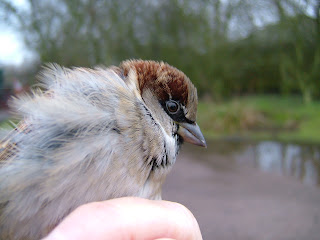As Errol was scribing, it was he who counted the total catch - 92 retraps and 71 new birds of 6 species . New = Tufted 56, Gadwall 9, Mallard 2, Pochard 2, Wigeon 1 and Teal 1. About one third of the retraps were Tufteds, getting on for half were Gadwall (they just stay feeding in or near the trap when it's cold) and the rest evenly split between Mallard and Wigeon.

Above: Three quarters of the team: Errol (scribing left), Chris (ringing middle) and Joe (dishing out the ducks, right) who - it turns out - I taught hedgelaying and coppicing to last winter at Shuttleworth College. I was behind the camera, briefly here and there, but I spent most of my time processing most of the retraps (and ringing one or two of each species. 6 ringing ticks in all - Thanks Chris!).

Above: A smart bird - Teal.

Above: A male Pochard

Above: A male Gadwall. A large percentage of these were already ringed. Does that make them quite site faithfull? It either means they are suckers for food in a trap or they know when they're on to a good thing!

Above: A male Tufted Duck.
As there are quite a few Pochard on the lake at present, we will be taking another catch quite soon.
For some other pictures of the ducks visit www.greenwoodringer.blogspot.com














